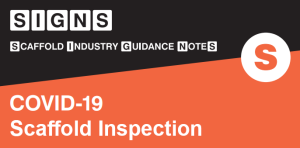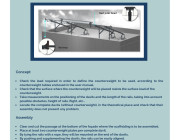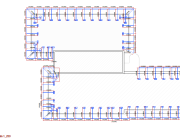Introduction to SIGNS
The Work at Height (WAH) Regulations 2005 set clear parameters for the routine inspection of work equipment and platforms like scaffolding. The COVID-19 pandemic means that contractors are currently operating in unprecedented circumstances, and there is confusion around how inspection compliance can be maintained during these unsettling times.
7 Day Statutory Inspections
Regulation 12 (4) of the WAH Regulations states:
“Every employer shall ensure that a working platform used for construction work; and from which a person could fall 2 metres or more, is not used in any position unless it has been inspected in that position or inspected on the site, within the previous 7 days.”
Where construction sites remain operational and scaffolding is in use there will continue to be a requirement for the statutory 7 day inspection to take place.
Where a construction site is ceasing to be operational, it is imperative that all scaffold structures are left in a safe and secure manner.
Periodic Inspections
Regulation 19 of the Construction (Design and Management) Regulations 2015 states:
“All practicable steps must be taken, where necessary to prevent danger to any person, to ensure that any new or existing structure does not collapse if, due to the carrying out of construction work, it may become unstable; or is in a temporary state of weakness or instability.”
Where construction sites are closing to prevent the spread of COVID-19 and the scaffolding will no longer be in use as a working platform, the statutory 7 day inspection will no longer be a requirement. The inspection routine would now become periodic and its frequency determined by risk assessment.
Regulation 12 (3) of the WAH Regulations states:
“Every employer shall ensure that work equipment exposed to conditions causing deterioration, which is liable to result in dangerous situations is inspected at suitable intervals; and each time that exceptional circumstances which are liable to jeopardise the safety of the work equipment have occurred, to ensure that health and safety conditions are maintained and that any deterioration can be detected and remedied in good time.”
Where a construction site is closed, it is assumed that there will be no risk of the scaffolding being overloaded, undermined, or damaged structurally by moving plant or vehicles. The main risk to scaffolding onsite in this situation would be the effects of adverse weather conditions.
Risk Assesment
A risk assessment is key when determining the frequency of periodic inspections and identifying scaffolds most at risk following adverse weather.
Some of the points you should consider when undertaking the risk assessment include:
Low Risk Sites
These are usually sites which are self-contained where there is low risk of the scaffold structure being compromised or components falling outside of the site boundary, for example:
- Sites with scaffold less than 10 metres in height
- Sites with fencing or hoarding where the scaffold is not adjacent to the boundary
- Commercial sites where the business operations have ceased
High Risk Sites
These are usually sites which are in the public domain, or are self-contained with a high risk of the scaffold structure being compromised or components falling outside of the site boundary, for example:
- Sites with scaffold over 10 metres in height
- Sites with sheeted scaffolds or temporary roofs
- Sites adjacent to utilities, highways or transport areas
- Commercial sites where the business operations continue to function
Undertaking Inspections
The Government are currently advising that people, except for essential workers, should stay at home because there is a direct risk to life from COVID-19. However, where undertaking inspection is necessary, the Government guidelines should be considered and implemented.
Before attending site to undertake inspections, it is important to have in place the following:
- The correct contact details of the Client or Principal Contractor
- Arrangements for gaining safe access to the site
- Suitable lone working procedures for the Scaffold Inspector
- COVID-19 risk assessment for the Scaffold Inspector
- COVID-19 risk assessment for any individuals required to undertake any necessary remedial works
Returning Scaffold into service
Regulation 13 of the WAH Regulations states:
Every employer shall so far as is reasonably practicable ensure that the surface and every parapet, permanent rail or other such fall protection measure of every place of work at height are checked on each occasion before the place is used.
A full inspection and handover will be required prior to any scaffold structure being put back into service and becoming operational to other trades.
Scaffolding used for Structural Support
Scaffolding that is not being used for as a working platform falls outside the statutory requirements of the WAH Regulations however it will still be subject to periodic inspection.
Examples include:
- Shoring scaffolds.
- Facade retention.
- Formwork support.
- Scaffolds designed for the storage of materials.
Periodic inspection of these structures should be risk assessed by the person responsible for temporary works onsite, and could include input from Permanent Works Designers, Structural Engineers, Temporary Works Designers, Manufacturers and Contractors, where appropriate.



















I like how you wrote about SIGNS: Scaffold Industry Guidance Notes Maquigestión Europea.
I want to share too, most trusted wholesale supplier list:
https://bit.ly/31tTure (maybe it will help someone)
Thanks and keep it up!